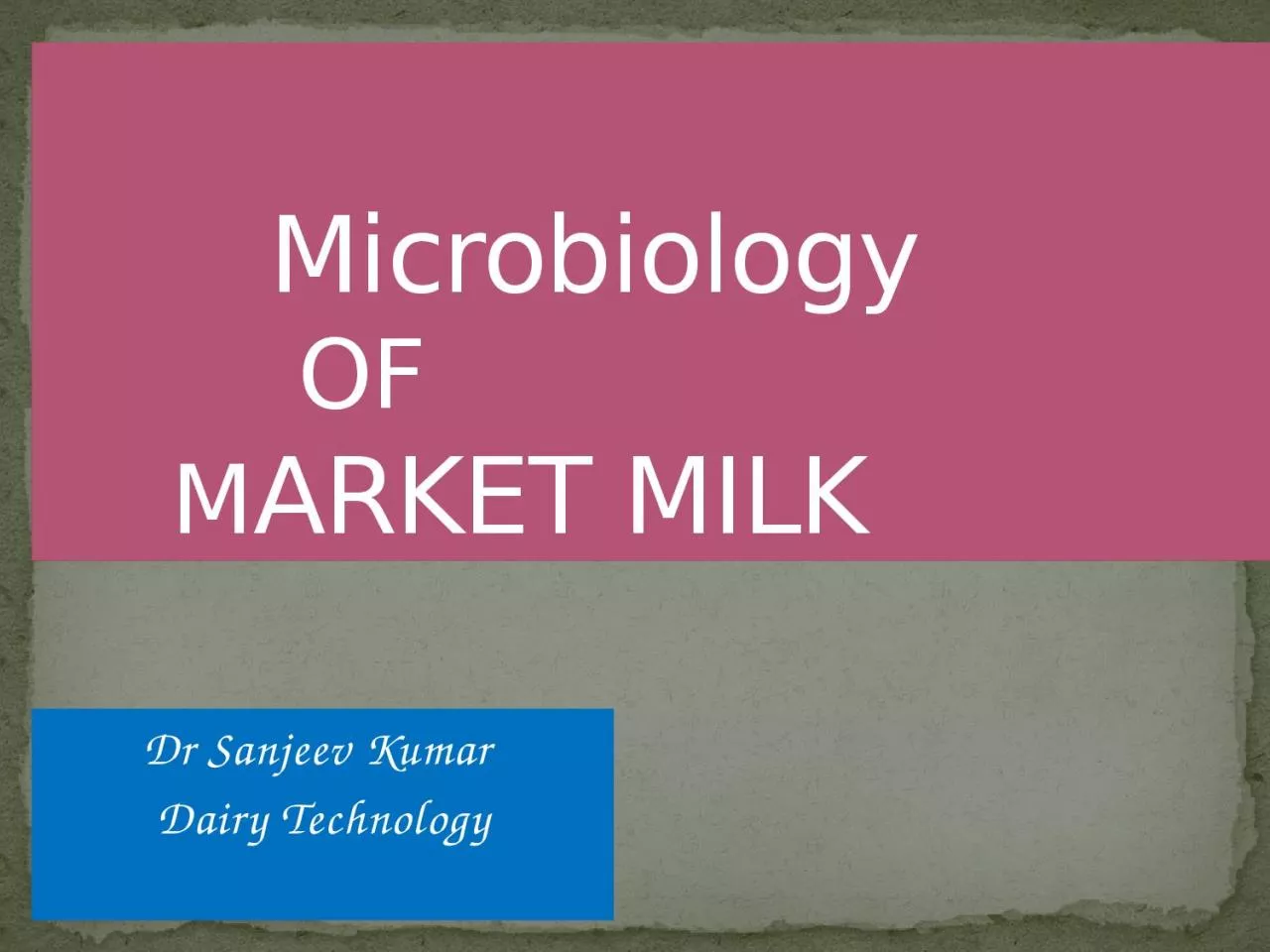

M ARKET MILK Dr Sanjeev Kumar Dairy Technology Microflora of Pasteurized milk Those surviving pasteurization temperature Those entering as postpasteurization contaminants Thermoduric Microflora ID: 1007010
Download Presentation The PPT/PDF document "Microbiology OF" is the property of its rightful owner. Permission is granted to download and print the materials on this web site for personal, non-commercial use only, and to display it on your personal computer provided you do not modify the materials and that you retain all copyright notices contained in the materials. By downloading content from our website, you accept the terms of this agreement.
1. Microbiology OF MARKET MILKDr Sanjeev Kumar Dairy Technology
2. Microflora of Pasteurized milkThose surviving pasteurization temperatureThose entering as post-pasteurization contaminantsThermoduric Microflora:-Microflora of Market Milk
3. Sources of thermoduric organisms:Insanitary conditions of milking equipmentInsanitary conditions of pasteurization plant( milk stone formation and improper cleaning of rubber parts)Repasteurization of returned pasteurized milk.Thermodurics start multiplying at warm stages during second pasteurizationSignificance:Due to temperature fluctuations, these organisms produce defects such as sweet curdling, gassiness, proteolysis, bitterness etc.Under refrigerated storage ,psychrotropic thermodurics like Bacillus and Clostridium spp.
4. Thermophilic microfloraThey grow well during holder method of pasteurization. Their upper limit for growth is 70°C.Types:- aerobic or facultative anaerobic sporeforming rods constitute majority of thermophilic microfloraLactobacillus thermophilusBacillus spp. likeSources: Their count is less in raw milk which significantly increases during holding at high temperatureThis group represents dairy plant rather than farm contaminationB. stearothermophilusB. thermoaciduransB. calidolactisB. coagulansRepeated use of improperly cleaned hodling vatsResidual milk foam and warm milk in dead ends/vatsRepasteurization of returned milkIncreases thermophilic count
5. Significance:Under ambient condtions, sporeforming bacilli cause spoilage problems like sweet curdling or bitty cream defects in pasteurized milk.Psychrotrophic microflora:Grow at refrigerated temperature(2°-7°C) irrespective of their optimum growth temperature.Most of them are mesophiles, some are psychrophilicTypes: divided into two categories
6. Sources: first category --> survival during pasteurizationSecond category --> post pasteurization contaminationWater supplies may serve as a possible source. Significance:At referigerated storage(7.2°C or lower) --> gram-negative psychrotrophs outgrow At 10°C or above --> thermoduric psychrotrophs tend to outgrowImportance of gram-negative psychrotrophs --> cause number of defects like fruity, rancid, bitter , putrid, roppiness and discoloration etc.Minimum population required to produce defects are 107/ml
7. Coliform bacteriaThis group of organisms refer to aerobic and facultatively anaerobic, Gram-negative, non-sporeforming rods which ferment lactose into acid and gas at32°C within 48hrs in presence of bile salts and dye.Types: Escherichia, Enterobacter, Klebsiella and CitrobacterSource:Destroyed during pasteurization.Post-pasteurization contamination.Improper cleaning/sanitizationUnhygienic handling practisesWater supplies Major sources of contamination
8. Significance:Unlike water supplies, where their detection is taken as index of faecal contamination, coliform detection in pasterurized milk is taken as index of post-pasteurizartion contamination. This group is usually traced to dairy plant.Above 7.2°C, they cause defects like roppiness, gassiness, unclean and medicinal off-flavours and bitterness.Pathogenic microorganismsThat survive pasteurization --> B. cereus, Cl. Perfringens, haemolytic streptococci and some virusesThrough post-pasteurization contamination --> dirty habits of handlers( E.coli, Salomella) or those carried by an unhealthy handler.L. monoctogenes and Y. enterocolitica can multiply even below 7.2°C but these species are heat labile.Improper storage of loose milk after such contamination is equally hazardous.
9. Microflora of UHT milkUltra-high temperature is carried out at 135°-150°C coupled with aseptic packaging.The only microflora survive UHT treatment are bacterial spore of thermophlic bacilli( B. stearothermophilus) and sometimes to mesophilic bacilli and clostridia.Major spoilage organisms in heat processed milk are, B. megaterium( main cause), B. firmus, B. polymyxa, B. coagulans and Clostridium spp.Microorganisms entering through faulty packaging practices are usually associated with stagnant water on dairy floors ( Pseudomonas, Coryneform, Micrococci etc).Major defects --> coagulation, bitterness and gassiness.
10. Microflora of Boiled MilkIn India, milk is boiled to 100°C for brief period before consumption.Boiling kills vegetative forms of all microbes except heat stable enterotoxins esp. of Staphylococci.Post pasteurization contamination can also occur due to improperly cleaned utensils and due to improperly heated portions of milk.Major defects--> off-flavour (proteolytic), coagulation and gassiness.Boiled milk should be utilized within 16 hrs, particularly in absence of refrigeration.
11.